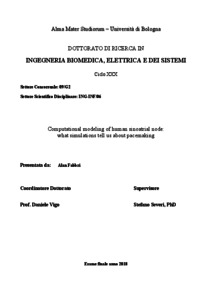Fabbri, Alan
(2018)
Computational modeling of human sinoatrial node:
what simulations tell us about pacemaking, [Dissertation thesis], Alma Mater Studiorum Università di Bologna.
Dottorato di ricerca in
Ingegneria biomedica, elettrica e dei sistemi, 30 Ciclo. DOI 10.6092/unibo/amsdottorato/8674.
Documenti full-text disponibili:
![[img]](http://amsdottorato.unibo.it/8674/1.hassmallThumbnailVersion/fabbri_alan_phD_thesis_final.pdf)  Anteprima |
|
Documento PDF (English)
- Richiede un lettore di PDF come Xpdf o Adobe Acrobat Reader
Disponibile con Licenza: Salvo eventuali più ampie autorizzazioni dell'autore, la tesi può essere liberamente consultata e può essere effettuato il salvataggio e la stampa di una copia per fini strettamente personali di studio, di ricerca e di insegnamento, con espresso divieto di qualunque utilizzo direttamente o indirettamente commerciale. Ogni altro diritto sul materiale è riservato.
Download (28MB)
| Anteprima
|
Abstract
The Sinoatrial node (SAN) is the primary pacemaker in physiological conditions. SAN tissue is characterized by auto-ryhthmicity, i.e. it does not need external stimuli to initiate its electrical activity. The auto-rhythmic behavior is due to the spontaneous slow depolarization during the diastolic phase. Understanding the biophysical mechanisms at the base of diastolic depolarization is crucial to modulate the heart rate (HR). In turn, HR modulation is fundamental to treat cardiac arrhythmias, so that atria and ventricles can fill and pump the blood properly.
The overall aim of the thesis is the investigation of the underlying mechanisms responsible for the pacemaking in human. To this end, a human computational model of the action potential (AP) of the SAN was developed. Pacemaking modulation at single cell level, effects of ion channel mutations on the beating rate and propagation of the electrical trigger from SAN to atrial tissue are the faced topics
The human single cell SAN model was developed starting from the rabbit SAN by Severi et al.; the parent model was updated with experimental data and automatic optimization to match the AP features reported in literature. A sensitivity analysis was performed to identify the most influencing parameters.
The investigation of pacemaking modulation was carried out through the simulation of current blockade and mimicking the stimulation of the autonomic nervous system.
The model was validated comparing the simulated electrophysiological effects due to ion channel mutations on beating rate with clinical data of symptomatic subjects carriers of the mutation.
More insights on pacemaking mechanisms were obtained thanks to the inclusion of calcium-activated potassium currents, which link changes in the intracellular calcium to the membrane.
Finally, the propagation of the AP from the SAN to the atrial tissue and the source-sink interplay was investigated employing a mono-dimensional strand composed by SAN and atrial models.
Abstract
The Sinoatrial node (SAN) is the primary pacemaker in physiological conditions. SAN tissue is characterized by auto-ryhthmicity, i.e. it does not need external stimuli to initiate its electrical activity. The auto-rhythmic behavior is due to the spontaneous slow depolarization during the diastolic phase. Understanding the biophysical mechanisms at the base of diastolic depolarization is crucial to modulate the heart rate (HR). In turn, HR modulation is fundamental to treat cardiac arrhythmias, so that atria and ventricles can fill and pump the blood properly.
The overall aim of the thesis is the investigation of the underlying mechanisms responsible for the pacemaking in human. To this end, a human computational model of the action potential (AP) of the SAN was developed. Pacemaking modulation at single cell level, effects of ion channel mutations on the beating rate and propagation of the electrical trigger from SAN to atrial tissue are the faced topics
The human single cell SAN model was developed starting from the rabbit SAN by Severi et al.; the parent model was updated with experimental data and automatic optimization to match the AP features reported in literature. A sensitivity analysis was performed to identify the most influencing parameters.
The investigation of pacemaking modulation was carried out through the simulation of current blockade and mimicking the stimulation of the autonomic nervous system.
The model was validated comparing the simulated electrophysiological effects due to ion channel mutations on beating rate with clinical data of symptomatic subjects carriers of the mutation.
More insights on pacemaking mechanisms were obtained thanks to the inclusion of calcium-activated potassium currents, which link changes in the intracellular calcium to the membrane.
Finally, the propagation of the AP from the SAN to the atrial tissue and the source-sink interplay was investigated employing a mono-dimensional strand composed by SAN and atrial models.
Tipologia del documento
Tesi di dottorato
Autore
Fabbri, Alan
Supervisore
Dottorato di ricerca
Ciclo
30
Coordinatore
Settore disciplinare
Settore concorsuale
Parole chiave
Cardiomyocytes,Computational models,Human sinoatrial node,Pacemaking modulation
URN:NBN
DOI
10.6092/unibo/amsdottorato/8674
Data di discussione
4 Maggio 2018
URI
Altri metadati
Tipologia del documento
Tesi di dottorato
Autore
Fabbri, Alan
Supervisore
Dottorato di ricerca
Ciclo
30
Coordinatore
Settore disciplinare
Settore concorsuale
Parole chiave
Cardiomyocytes,Computational models,Human sinoatrial node,Pacemaking modulation
URN:NBN
DOI
10.6092/unibo/amsdottorato/8674
Data di discussione
4 Maggio 2018
URI
Statistica sui download
Gestione del documento:


 Login
Login
